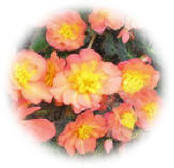|
 |
MULTIFLORA BEGONIAS
Dennis Need |
 |
|
These small flowered tuberous begonias owe much to the discovery of B;davisii,
which was collected by W. Davis when on a plant collecting expedition for
Veitch and Sons in 1876. It was discovered in the Andes at Chupe, Peru,
growing at 10,00 feet. Its dwarf compact habit has been passed on to its
ancestors which makes an ideal plant for bedding during the summer months |
|
. |
|
 |
The nearest cultivated variety to the original species, is “Le
Flamboyant”, bred by the French hybridist Arthur Billard in 1911. Whilst
it is classified as a single, the centre is composed mainly of small petaloids rather than anthers. |
 |
|
. |
|
 |
“Frau Helenč Harms” came from Germany circa 1904. It is interesting to
note, that a friend of mine using seed saved from B; pearcei, had a
number of seedlings virtually identical to this variety. So we can assume
that this variety arrived under similar circumstances. |
|
. |
|
 |
Another of Arthur Billard’s varieties shown is “La Madelon” introduced in
1919, again listed as a single, but similar to “Le Flamboyant” in that the
centre is composed of petaloids and not anthers. This is an extremely free
blooming variety and makes a wonderful show from early summer through to
late autumn. |
 |
|
. |
|
 |
“Madame Richard Galle” came on the scene about 1932 in Belgium, this being
a sport of the variety “Ami Jean Bard”. It is sad that the brighter
coloured.
|
 |
|
. |
|
“Ami Jean Bard” no longer appears to be grown commercially. |
|
. |
|
 |
I have been trying to increase the range of multiflora varieties during
the past 10 years with limited success, and have to date only managed a
small number. “Peardrop” being one that is different, named by my
Daughter, as she thought the colour combination was similar to the sweets
called Peardrops she had as a child. This is a totally different colour
combination as can be seen from the picture, although at the height of
summer the yellow centre can fade. |
|
. |
|
 |
“Yellowhammer” the first variety I bred, makes a brilliant display, being
the brightest yellow begonia I have ever seen. The picture does not do
justice to glowing colour seen when planted in a bed in full sun. |
|
. |
|

Redcap |

Lemon Bergermaster |

Pink Bergermaster |

Apricot Bergermaster |
|
. |
|
I hope the pictures of the cutting raised multiflora varieties shown, will
encourage more gardeners to grow them, as they make a neater more free
blooming display than the seed raised varieties. |
|
.
|
|
|
|
|
|
|
OTHER PAGES
BY DENNIS NEED
RECENT & NEW
BEGONIAS FOR 2009
2008 CULTURAL DIARY -
Multiflora & Garden Begonias
Basket or Pendula
Begonia Cultivation
Begonias in the Garden
Basket Begonia Gallery |